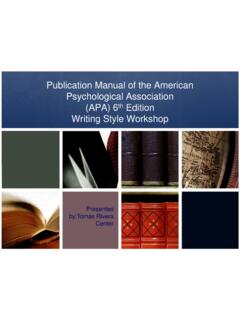Transcription of Turabian Citation and Format Style Guide
1 7/4/2003 1 Turabian Citation and Format Style Guide This Guide introduces the Turabian Format and provides examples of Citation styles you might use in research papers. Additional examples and explanations may be found in Turabian 's A Manual for Writers of Term Papers, Theses and Dissertations, Sixth Edition, revised by John Grossman and Alice Bennett (LB2369 .T8 1996), available in the circulating stacks and at the reference desk. Turabian 's lengthy and legendary career as a dissertation secretary at the University of Chicago provided her the opportunity to publish several editions of the Manual, each one prompted by a revision of The Chicago Manual of Style .
2 This sixth edition of Turabian conforms to the fourteenth edition of The Chicago Manual of Style (Z253 .U69 1993-Reference Desk). CONTENTS: Which subject areas use the Turabian standard? What is the basic Format of the academic paper? Parenthetical Reference system of Citation explained Use of Footnotes and Endnotes explained Citations in all formats Format for citing electronic sources Links to other Turabian Citation guides Which subject areas use the Turabian standard? Turabian may be used in any class or course of study, including the humanities, social sciences, and natural sciences. Many people use Turabian as a catchall, for instance, when they do not know which Style Format their professor prefers.
3 It is always best to find out from your professor which Style he or she prefers. If this is not possible, at least be consistent in choosing one Style of presenting bibliographic information and using it throughout your paper. What is the basic Format of the academic paper? The academic paper generally consists of three parts: (1) the front matter (title page, copyright page, dedication and/or epigraph, table of contents, lists of illustrations or tables, acknowledgements, abstract, etc.); (2) the text; and (3) the back or reference matter (appendixes, endnotes, bibliography). The text of the research paper should be double-spaced, with the exception of indented block quotes, which can be single-spaced.
4 Bibliographies, footnotes, and itemized lists should be single-spaced. All pages "count" in a numbering system, although some pages, like the title page or dedication page, may not actually have numbers printed on them. Pages considered front matter should be numbered with consecutive lower case roman numerals in the bottom center. The rest should be numbered with Arabic numerals. Number the first page of text, and other pages with titles, in the bottom center, and number all other pages (including the back matter) in the top center or upper right corner. Turabian 's Manual spells out rules and conventions for chapter headings and subheadings, abbreviations, the use of numbers in text, alphabetizing non-English names, designations of tables, and the like, and there is simply no substitute for consulting the Manual directly for advice on these issues.
5 Finally, recognizing that this manual may be used in any discipline, Turabian offers advice on different systems of Citation Style . It recommends the parenthetical reference, or author-date, Style of Citation with corresponding Reference List for papers in the natural and social sciences (see chapter 10 of the Manual), and a system using footnotes or endnotes (see chapter 8 of the Manual) and corresponding 7/4/2003 2 Bibliography (see chapter 9 of the Manual) for most papers in the humanities. (The two documentation styles are compared at chapter 11.)
6 The Style you choose should be consistent with your professor's instructions. Parenthetical reference system of Citation explained Turabian recently added Format advice for writers of academic papers desiring to use parenthetical references, alternately called the author-date system. Some scholars note that this Citation system has now become the most widely used system, especially in the natural and social sciences. This system places, within the text of the paper, a reference to a different work within a set of parentheses. The parentheses contain the author of that referenced work (or compiler, translator, or editor), its date of publication, and a page reference, if appropriate.
7 Each source represented by a parenthetical reference within the text must be included in the Reference List. The Reference List entry will be a complete bibliographic Citation , including author, title, source, publisher, and date of publication. Turabian advices that the bibliography might be more accurately called a Selected Bibliography, Works Cited, or Sources Consulted list. Usually, it is in the form of a single, alphabetical list. It is single-spaced with one blank line between entries. The first line of each entry is flush left with subsequent lines indented five spaces. Footnotes and endnotes explained Turabian explains that the Citation system using footnotes with a corresponding bibliography has long been favored in the humanities, but, with this edition, recognizes that many disciplines are abandoning it in favor of the author-date system of documentation.
8 Notes have four basic purposes: (1) to cite authority for statements made in the text; (2) to make cross-references; (3) to amplify, qualify, or comment on material in the text that would break up the flow of the text if included there; and (4) to make acknowledgments. The first two purposes define reference notes, the last two, content notes. Note numbers should be placed in the text following the passage requiring it, in Arabic superscript (a half space above the line). In current versions of Microsoft Word, selecting Insert, followed by Reference, followed by Footnote will automatically set up your superscript number, as well as automatically place the footnotes in numerical order for you.
9 Numbers should be in numerical order beginning with 1. Corresponding footnotes should be placed at the bottom of the page containing the footnote reference, separated from the text by a separator, a short line made by underscoring. Footnotes can begin with a superscript number or a regular number on the same line as the text (preferred by Turabian ). If a superscript is used, there needn't be a space between it and the body of the note. If an on-line numeral is used, a period and a space should follow it. The first author's family name comes before his or her given name in a bibliography; subsequent contributing authors names are not inverted. When a bibliography contains several works by the same author, subsequent entries replace the author's name with an eight-space underscore followed by a period.
10 Primacy of such entries may be determined alphabetically or chronologically. Where a single author has several types of entries, they go in this order: works written by the author as single author, works edited by author (ed.), works translated by author (trans.), works compiled by author (comp.), and then co-authored works by author. Citations in all formats The following are examples given in the Footnote/Endnote (N) Format , with its corresponding Bibliography (B) entry, and the Parenthetical Reference (PR) Format with its corresponding Reference List (RL) entry. Examples are based on the sixth edition of A Manual for Writers of Term Papers, Theses and 7/4/2003 3 Dissertations by Kate L.






